 www.U-35.com
www.U-35.comThe Homepage for U-35, a Type VII U-Boat
... 1936 - 1939 ...
 www.U-35.com
www.U-35.comThe Homepage for U-35, a Type VII U-Boat ... 1936 - 1939 ... |
|
|
|
|
|
|
|
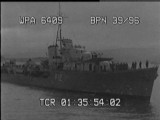 HMS KINGSTON and HMS KASHMIR arriving in Greenock
(near Glasgow), Scotland, on Friday, 01 December 1939.
HMS KINGSTON and HMS KASHMIR arriving in Greenock
(near Glasgow), Scotland, on Friday, 01 December 1939. |
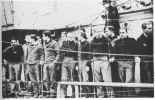 The crew of U-35 arriving at Greenock on 01 December 1939. The original caption to this wartime magazine photo read: "Most of the forty-three prisoners expressed distaste at their task of sinking defenceless ships and seemed glad that their share in this type of warfare is finished." Pictured: Ernst Weber, Siegfried Kienast, Gerhard Freier, Wilhelm Janssen,
Siegfried Bruse, Johann van der Pütten, Martin Müller,
Karl Sommerer. [19,33,38]
The crew of U-35 arriving at Greenock on 01 December 1939. The original caption to this wartime magazine photo read: "Most of the forty-three prisoners expressed distaste at their task of sinking defenceless ships and seemed glad that their share in this type of warfare is finished." Pictured: Ernst Weber, Siegfried Kienast, Gerhard Freier, Wilhelm Janssen,
Siegfried Bruse, Johann van der Pütten, Martin Müller,
Karl Sommerer. [19,33,38]
|
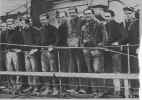 Front row: Johannes Weigand,
Siegfried Bruse, Martin Müller, Karl Sommerer, Theodor Schütt, Albert Schrader, Kurt Grosser, and Paul Fichte
[33,38]
Front row: Johannes Weigand,
Siegfried Bruse, Martin Müller, Karl Sommerer, Theodor Schütt, Albert Schrader, Kurt Grosser, and Paul Fichte
[33,38]
|
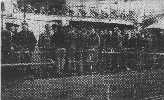 [65] [65]
|
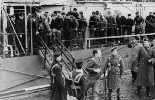 The crew of U-35 departing the ship. [33]
The crew of U-35 departing the ship. [33]
|
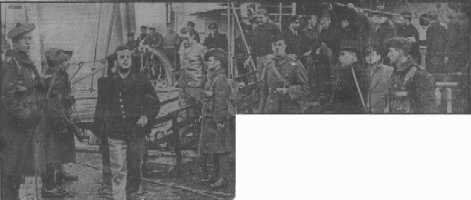 Part of the crew of U-35 departing HMS KASHMIR. Recognizable: Paul Liebau, Fritz Pietsch, Gustav Horstkötter, and Gerhard Stamer. [60,75]
Part of the crew of U-35 departing HMS KASHMIR. Recognizable: Paul Liebau, Fritz Pietsch, Gustav Horstkötter, and Gerhard Stamer. [60,75]
|
The U-35 officers and the cook, Martin Müller, were moved to the POW camp at Grizedale Hall, in the Lake District of northern England, on 09 December 1939. The rest of the crew were moved to Camp 127 at Oldham, Lancashire on 09 and 13 December 1939. [5,17,39]
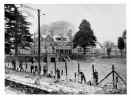 Grizedale Hall - Lager 1. Here British troops are seen erecting the barbed wire perimeter fencing. Photo credit - International Red Cross.
Grizedale Hall - Lager 1. Here British troops are seen erecting the barbed wire perimeter fencing. Photo credit - International Red Cross.
|
Prisoners of War being paraded on the streets of Gravenhurst, Ontario, Canada: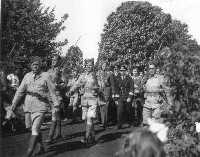
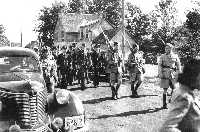
|
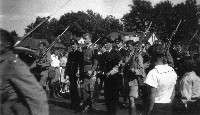
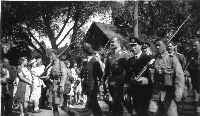 |
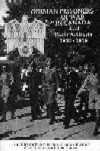 As part of this series of photographs, Gerhard Stamer is featured on the cover of the 1993 book by Chris Madsen and Bob Henderson, "German Prisoners of War in Canada And Their Artifacts 1940-1948". [24]
As part of this series of photographs, Gerhard Stamer is featured on the cover of the 1993 book by Chris Madsen and Bob Henderson, "German Prisoners of War in Canada And Their Artifacts 1940-1948". [24]
|
The crewmembers were later moved to Fort Henry.


|
The officers ware later moved back to Gravenhurst. Luftwaffe pilot Ulrich Steinhilper remembers Gerhard Stamer there, and includes this group photograph in his memoirs. [29]:
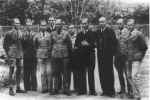 Officers at the Gravenhurst
POW camp. Hptm. Neumann, Hptm. Fiebig, Obltn. Machui, Kptltn. Max Schulte (U-13), Maj.
Wüstefeld, Oblt. z. S. Albrecht, Kptln.
(Ing.) Gerhard Stamer, Kptln. (Ing.) Schilling (L.I. U-33), Maj.
Keil, Obltn. Hennings [30]
Officers at the Gravenhurst
POW camp. Hptm. Neumann, Hptm. Fiebig, Obltn. Machui, Kptltn. Max Schulte (U-13), Maj.
Wüstefeld, Oblt. z. S. Albrecht, Kptln.
(Ing.) Gerhard Stamer, Kptln. (Ing.) Schilling (L.I. U-33), Maj.
Keil, Obltn. Hennings [30]
|
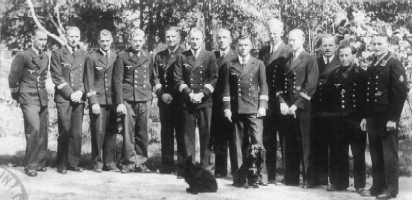 In the Gravenhurst POW camp, from left: Gerhard Stamer (U-35), Heinz Erchen (U-35),
Hermann Beckmann (U-27), Albert Schrader (U-35), Werner Lott (U-35), Johannes Franz (commander,
U-27), Friedrich Ernst Otto Schilling (LI, U-33),
Hans Jenisch (commander,
U-32), Hans-Joachim Roters (U-35),
Johannes Becker (2WO, U-33), Anton Thimm (LI, U-32),
Fritz Erbshäuser (U-32), [unknown]. [76] The dog on the left was
named "Hexe" (witch) and belonged to Hans-Joachim Roters;
the dog on the right was named "Flaps" and belonged to Becker.
[33]
In the Gravenhurst POW camp, from left: Gerhard Stamer (U-35), Heinz Erchen (U-35),
Hermann Beckmann (U-27), Albert Schrader (U-35), Werner Lott (U-35), Johannes Franz (commander,
U-27), Friedrich Ernst Otto Schilling (LI, U-33),
Hans Jenisch (commander,
U-32), Hans-Joachim Roters (U-35),
Johannes Becker (2WO, U-33), Anton Thimm (LI, U-32),
Fritz Erbshäuser (U-32), [unknown]. [76] The dog on the left was
named "Hexe" (witch) and belonged to Hans-Joachim Roters;
the dog on the right was named "Flaps" and belonged to Becker.
[33]
|
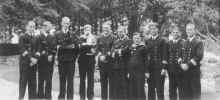 U-35 and U-42 crewmembers in Gravenhurst.
U-35 and U-42 crewmembers in Gravenhurst.
L-R: Gerhard Stamer (U-35), Heinz Erchen (U-35), Hans-Joachim Roters (U-35), Albert Schrader (U-35), Werner Lott (U-35), Rolf Dau (Commander of U-42), Siegfried Ludwig (U-42), Julius von Gosen (U-42), Otto Meye (U-42), Max Dünnebier (U-42). [53] |
|
Standing, from left: Hannes Thieme, Karl Schnute, Erich Bartold May, Hubert Hirsch, Wilhelm Janssen. Seated: Walter Kalabuch, Paul Liebau, Gottlob Wilhelm Fischer, unknown, Martin Müller. |
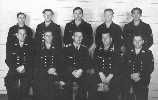 Standing, left to right: Gerhard Marx, Heinz Küfner, Stefan Döbele, Theodor Schütt, Walter Roloff. Standing, left to right: Gerhard Marx, Heinz Küfner, Stefan Döbele, Theodor Schütt, Walter Roloff.Sitting, left to right: Peter von der Helm, Gerhard Oppermann, Richard Friedrich Lüneburg, Fritz Pietsch, Ernst Weber. [70] |
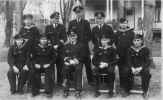 U-35 crewmembers assembled at the Grande-Ligne POW camp in Quebec, Canada, 1944.
U-35 crewmembers assembled at the Grande-Ligne POW camp in Quebec, Canada, 1944.Standing, L-R: Gerhard Freier, Heinz Erchen, Hans-Joachim Roters, Gerhard Stamer, Paul Fichte Seated, L-R: Albert Schrader, Siegfried Kienast, Werner Lott, Peter Schwarz, Kurt Grosser. [33] |
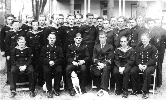 A photo of POWs at Grande-Ligne. Included in the picture
from U-35: Kurt Grosser, Paul Fichte, Peter Schwarz, Siegfried Kienast, Albert Schrader, and Gerhard Freier. [53] A photo of POWs at Grande-Ligne. Included in the picture
from U-35: Kurt Grosser, Paul Fichte, Peter Schwarz, Siegfried Kienast, Albert Schrader, and Gerhard Freier. [53]
|
 Siegfried Bruse as
a Prisoner of War. Siegfried Bruse was running the
canteen at Bowmanville when the authorities decided that the POWs should have beer in the camp.
Siegfried Bruse as
a Prisoner of War. Siegfried Bruse was running the
canteen at Bowmanville when the authorities decided that the POWs should have beer in the camp.|
|
Crews |
|
|
|
|
 (relative of
U-35 Chief Engineer Gerhard Stamer)
(relative of
U-35 Chief Engineer Gerhard Stamer)